Five—
Private Worlds Made Public:
The Readymades
The Large Glass and Given were Duchamp's most elaborate and considered projects, but what made the broadest impact and gave him the most lasting notoriety—greater even than the succès de scandale of the Armory Show—were the "readymades": ordinary objects of everyday use, some slightly altered and others not, displayed in a setting that promoted them to the status of art. Today the readymades stand as Duchamp's signatory challenge to artistic tradition, his irreparable violation of the sacred precinct where art had reposed in sovereign independence from the rest of life, and to which were admitted only those rare or unique objects that exceptionally endowed creators had infused with special qualities of vision, imagination, or skill.
Audiences had long been surprised and disconcerted by modernist and vanguard innovations, but whether in impressionism, fauvism, or cubism, these had been undertaken for some aesthetic purpose, to expand art's subject matter, extend its expressive range, or heighten its perceptual power. Duchamp's readymades mounted their challenge from outside the recognized sphere of artistic practice; their novelty consisted precisely in breaching the boundary between art and non-art, relegating that distinction to the same fragile status of the "merely conventional" to which earlier modernists had consigned classicism or re-
alism. With the readymades, vanguard practice entered a new territory, one that the critic Clement Greenberg has called "avantgardism ," the now familiar form of activity in which "the shocking, scandalizing, startling, the mystifying and confounding, became embraced as ends in themselves and no longer regretted as initial side-effects of artistic newness that would wear off with familiarity." We still live with the consequences of this challenge, which has made us recognize "that any thing that can be experienced esthetically can also be experienced as art .... The notion of art, put to the strictest test of experience, proves to mean not skillful making (as the ancients defined it), but an act of mental distancing—an act that can be performed even without the help of sense perception. Any and everything can be subjected to such distancing, and thereby converted into something that takes effect as art."[1]
Duchamp understood well enough that to offer objects like bicycle wheels, bottle racks, combs, or urinals as artworks was to break down the assumed boundaries of the aesthetic realm, but the reasons he often gave for turning to readymades stressed a different motivation: the readymades were a defense against personal fixity. Because the various objects did not look alike, had different visual qualities and features, he could "produce" a series of them without repeating himself, without developing any defined personal style or taste; and taste, he declared, was merely a habit, "the repetition of something already accepted," a mark or stamp that identified some particular, recognizable individual. Readymades were therefore a way to preserve an undefined, fluid existence, in contrast to that of the conventional artist, whose presence in a series of works could be recognized by known elements of style. To assure that the readymades fulfilled this task, it was necessary that his choice of individual items be based on "visual indifference": no element of personal preference could be allowed to enter into it. One way Duchamp sought to enforce this condition was by committing himself to designate some object as a readymade at a predetermined future moment when (presumably) he did not know where he would be or what would be available. The result would be "like a speech delivered on no matter what occasion but at such and such an hour . It is a kind
of rendezvous." What he sought to avoid, he said, was responsibility; he would leave behind works, but he was not their maker.[2]
Duchamp's notion that the absence of habit was an important condition of freedom was another of his ties to Jules Laforgue. In a posthumously published fragment, Laforgue wrote that "the idea of liberty would be to live without any habits . Oh, what a dream! What a dream! It's enough to drive you crazy! a whole existence without a single act being generated or influenced by habit. Every act an act in itself ."[3] Laforgue's dream of an existence free of fixity developed out of the impersonal poetics of Mallarmé, whose writing Duchamp admired and whose allusive, fluid, musical style is echoed in Young Man and Girl in Spring , where the indeterminate freedom of the two figures is signaled by their having no faces. Early in his artistic career Duchamp's personal fluidity and lack of fixity appear as a kind of natural impulse, expressed in his rapid passage from one style of painting to another. In 1915 (around the time when the notion of readymades was occurring to him) he told a New York reporter that his methods were constantly changing and that his most recent work was "utterly unlike anything that preceded it"; he sought no definitive form of expression, and "in the midst of each epoch I fully realize that a new epoch will dawn."[4]
By the time Duchamp offered this self-description, however, the period in his life to which it applied was past. In 1912 he committed himself to long years of devotion to a single work, the Large Glass. The stable identity this gave him was partly undercut by the Glass's quality as a "delay" that kept him, like its subject, in perpetual suspension, and partly by his inability or refusal to finish it. All the same, his earlier way of embodying fluidity was gone, and what had formerly appeared as a spontaneous impulse to be always moving on now became self-conscious and in need of different forms of support. Late in his life, Duchamp told an interviewer: "I force myself to contradict myself so as to avoid conforming to my own taste."[5] That he was seeking new ways to avoid leaving a personal imprint on his work after 1912 is suggested by his use of mechanical drawing for several images in the Glass, the glider, chocolate grinder, and oculist witnesses; such drawing, he later explained, "upholds no taste, since it is outside pictorial conven-
tion." It was one way in which he sought visual form for what he called the "beauty of indifference."[6]
It was during his years of work on the Large Glass that Duchamp also adopted a more radical strategy for undermining the stability and coherence of his own identity: his assumption of a second and female persona as Rrose Sélavy. We shall meet Rrose more at length later on, but her ties to the goal of breaking the link between personality and artistic style are announced in one of the projects Duchamp attributed to her: it was to sign some well-known pictures with the name of an unknown artist or one known to work in a contrasting style, or to sign unknown pictures with a name that called up an easily recognizable but quite opposed visual language. "The difference between the 'treatment' and the name which the 'experts' don't expect—is the authentic work of Rrose Sélavy and foils imitations."[7]
Duchamp's notion that readymades provided a defense against any formed and stable identity has not been used as a basis for understanding them as often as accounts, like Greenberg's, that emphasize the way they elevate shock, scandal, and mystification to ends in themselves. However, we need to give close attention to both purposes. Duchamp valued these objects at least as much for the effect they could have on his own person and persona as for their impact on the larger world of artistic practice, and only by tracing their roots in his personal universe of preoccupations can we grasp how they came to be part of his repertoire and how they migrated into the realm of public art.
Most commentators are content to regard all Duchamp's readymades as forming a single group, inspired by the same aims and goals. Such a view makes understanding the readymades impossible, because it blots out the features of them that only become visible by tracing their evolution. Duchamp himself pointed the way to recovering these features, when he reminded interviewers that his first interest in ordinary objects was not directed by the concerns he later brought to them, and that the term "readymade" did not exist until 1915, two years after he began to acquire (and in some cases to alter) objects that would later be named with it. These readymades avant la lettre were the bicycle wheel he mounted on a wooden stool in 1913, the reproduction of a banal
landscape to which he added red and green dots, giving it the name Pharmacy in January of 1914, and the metal rack for drying bottles he purchased and put in his studio later in the same year.
Speaking about them to Pierre Cabanne in 1966, Duchamp insisted that these early objects were not intended as provocations, and that he did not start out by thinking of them as "art." They were mere "distractions," things he bought or did for no particular reason-at least none that he was able or willing to recall by then. The first part of this account, that the objects were not intended to be provocative or to take the place of "art," seems confirmed by the circumstances in which Duchamp turned to them, but we cannot accept the claim that his attraction was casual and unmotivated. His failure to remember the source of his interest veiled the objects' links to a set of intensely personal concerns and interests, whose role in bringing forth readymades contradicts his later view of them as inspired by indifference.
To understand what drew Duchamp to his early objects we must call up one feature of his personality that has concerned us only a little so far, namely his powerful—at times it seems nearly uncontrollable—fascination with puns. He punned happily in some of the cartoons he did for satirical papers while still a student, for instance in the conversation in "Flirt" (1907), where a piano's ability to give an aural impression of ocean waves is attributed to its being a piano aqueux , turning the French term for a grand piano (piano à queue , "with a tail") into "watery piano." Later he would take pleasure in playful and complicated sentences, some dizzying and more or less untranslatable like "esquivons les ecchymoses des Esquimaux aux mots exquis," some singingly sexual like "Faut-il mettre la moelle de l'épée dans le poil de l'aimée?" (cleverly rendered by Elmer Peterson as "Should you put the hilt of the foil in the quilt of the goil?"), some simple and silly, such as "moustiques domestiques demistock" (half-stock domestic mosquitoes); and there were dozens of others. One of the best known was the phonetic sentence he wrote beneath his altered version of the Mona Lisa (to which we will return later), L.H.O.O.Q. ("elle a chaud au cul," "she has a hot ass"); but this was only one of many similar games: L.M.A.P. (either: "elle est ma p[épée]," "she is my broad"; or "elle aime à p[omper]," "she likes to suck"), L.H.I.E.O.P.I. ("elle a chié au pays,"
"she shat in the country"). According to Gianfranco Baruchello, Duchamp kept a box under his bed "full of pages and pages" of such things.[8]
A person so open to games like these is one for whom the world is, as Baudelaire put it, a "forest of symbols," a constant invitation to decode hidden relationships beneath the apparent inertness of sounds and objects. The Large Glass has its share of puns: the first syllables of mar iée and cél ibataires combine to produce his own name; the nonsensical adverb that concludes the title slyly proclaims that the bride loves him, La Mariée mise à nu par ses célibataires, même [m'aime ]; the "oculist witnesses" carry a voyeuristic sexual innuendo, oculiste = au culiste, repeated in the business card of Rrose Sélavy (herself a pun, "éros c'est la vie"), which offered "precision oculism" (L.H.O.O.Q. contains nearly the same word play). In the notes, the Large Glass was described as a "machine agricole," or farm machine, which in French suggests the equivalent "machine du champ," field machine or Duchampian machine. (The phrase may also have echoed the title of a Laforgue poem, "Comice agricole," or "Country Fair.") Strangely, no evidence seems to exist that Duchamp was aware of the pun that linked the Large Glass with his turn to ordinary objects: a bride stripped bare is a ready maid. But it seems impossible that he did not know.
The all-pervasive presence of puns in Duchamp's world of imagination shows that his was a mind that constantly slid back and forth between one potential meaning of a sign and another, giving birth to multiple significations where conventional expectations did not suggest any. His later insistence that the readymades were based on "indifference" has kept interpreters from seeing how such plays of meaning linked them to things he cared greatly about. Admittedly, the evidence for the readings that follow depends on inference, and some people may decide to remain unconvinced, particularly those who cherish Duchamp as an icon of meaninglessness or a witness to the irrelevance of any artist's or author's intentions. But of the three objects he later described as "distractions," one is a simple visual pun, and the others call up major themes in the Large Glass and in the personal evolution that led him to it, through the kinds of idea and word play he loved so much. Later on we will see that opening ourselves up to the same playful presence of meaningful connections where convention seems to ex-
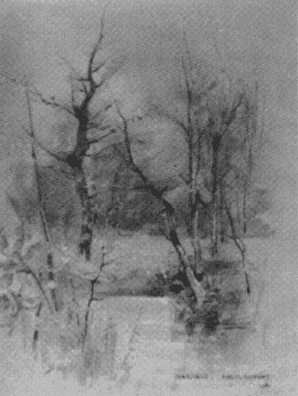
Figure 37.
Duchamp, Pharmacy (1914)
clude them will reveal a hitherto unsuspected but closely woven network of linkages joining many of Duchamp's other objects.
The simple visual pun was the proto-readymade called Pharmacy , produced by altering a coloring-book landscape bought in an art supply store (Fig. 37). The landscape contained two lights in the background, which could be colored in; by making one red and one green, and then labeling the scene, Duchamp created a play between them and the tubes of red and green liquid that are the universal sign of French apothecary shops. But behind this gesture lay a personal story: in 1911 Duchamp's favorite sister, Suzanne, had married a pharmacist, a marriage that was breaking up just at the moment when Duchamp executed his "distraction," in the half-light of a train taking him to visit his family in Normandy. (It was an earlier visit, soon after the wedding, that had helped inspire the image of himself as a Sad Young Man on a Train .) Associating Suzanne's failed marriage partner with the banality
of the coloring-book landscape was a not-too-subtle act of aggression against him.[9]
Pharmacy shows that Duchamp's turn to ordinary objects gave scope to his penchant for puns in visual form, adding weight to the evidence that points to similar links between sign and meaning in the other proto-readymades. The first of these, the bicycle wheel, was not really a readymade at all, since its everyday state is to be mounted on a bicycle frame, and even if Duchamp found one by itself in a shop, he still had to take the trouble of attaching it to a stool in order to make it serve his purpose (Fig. 38). The basic lineaments of that purpose seem hard to overlook. No idea was more important in his work than the idea of motion; in 1913, when he put the wheel in his studio, Duchamp had recently abandoned the interest in linear motion and the "dissolution of form" evidenced in Sad Young Man on a Train, Nude Descending a Staircase , and the various images of "speedy" or "swift" nudes, in favor of a type of movement that remains suspended in a space it never traverses—a "delay." The Large Glass contained (since we are in 1913 we should say was to contain) two objects whose action of turning on an axis while going nowhere is echoed by the mounted wheel—the chocolate grinder and the waterwheel. The bicycle wheel, altered so that its circular movement no longer produced linear progression, precisely captured Duchamp's shift of interest from the first form of motion to the second, a reminder of the turn his career had taken and of the Glass that was now his major project. In addition, mounting the wheel—roue —on a stool—sel —created an eminently Rousselian tribute to the writer whose "delirium of imagination" he found so remarkable.[10]
That Duchamp understood his appropriation of the bicycle wheel in just this way, as enclosing the attempt to achieve linear motion within an imagined, interior space, is suggested by a drawing he did in 1914, To Have the Apprentice in the Sun (Avoir l'apprenti dans le soleil , Fig. 39). It shows a cyclist, mounted on a bicycle and bent over as if putting effort into pedaling, but the bicycle rides on a string that is quickly declared to be a mere drawn line, not a possible high wire, because it stretches between the fourth line of one musical staff and the space above another, its bottom end beginning in a loop and its top one suspended in space. Duchamp locates the subject of his drawing in

Figure 38.
Duchamp, Bicycle Wheel (1913)
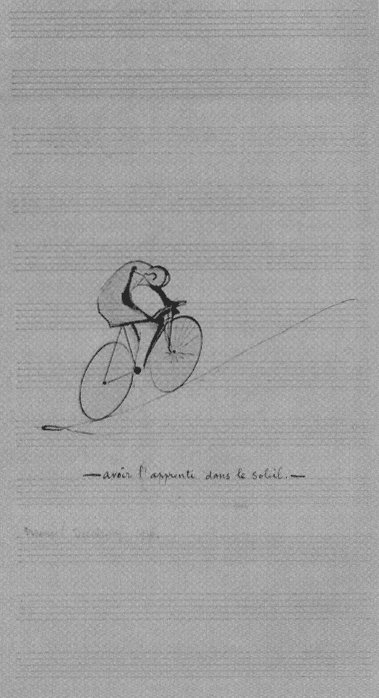
Figure 39.
Duchamp, To Have the Apprentice in the Sun (1914)
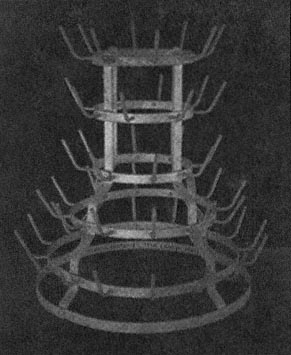
Figure 40.
Duchamp, Bottle Rack (1961 reproduction of lost original, 1914)
a region beyond physical experience like that of the Large Glass by giving it a nonsense title, foreshadowing the inscriptions later attached to the readymades, and the cyclist's appearance of straining to climb a slope whose top remains beyond reach echoes the image of the bride as a motorcar that "roars triumphantly" at the moment when it is "exhausted by hope." Putting the drawing on music paper recalls the symbolist celebration of music as the exemplary art of interiority, the quality Walter Pater had in mind when he famously declared that "All art aspires to the condition of music." Duchamp's drawing puts the bicyclist—and by implication the mounted wheel as well—inside that condition, the transformation of physical motion into inwardness that he called delay.
Just as closely linked to the bride and the bachelors was the third of the early or proto-readymades, the bottle rack (Fig. 40). Its symbolism is so direct and apparent that one might hesitate to think Duchamp had it in mind, if we did not know how readily he pounced on such sexual associations: the rack asks to be completed by having wet bottles
hung on its prongs, a desire that can only be characterized as obviously, laughably Freudian. (Its form also recalls the phallic appurtenances of the first drawing Duchamp named with the figures of bride and bachelors, the one done in Munich [Fig. 26].) Not surprisingly, this interpretation of the rack was proposed by Arturo Schwarz (whose fondness for Freudian readings of everything has been, to put it kindly, exemplary) while Duchamp was still alive, and according to Schwarz Duchamp accepted it. That he did is another strike against the claim that the readymades were chosen out of indifference, but Schwarz was unable to see how neatly the rack echoes the major themes of the Large Glass, because in his eyes everything Duchamp did had to be brought back to the incestual fantasies about Suzanne. What makes the rack resonate so perfectly with the Glass is the absence of the bottles for which the prongs call out (nothing easier than to provide some), so that the female counterpart to the symbolic male anatomy exists only by being imagined; male and female await each other in fantasy, while being denied—or spared—physical contact. As in the Large Glass the male realm is that of ordinary time and space (its symbolic equivalent resting firmly on the ground) while, above it, the female one beckons out of the immaterial world of the imagination, casting the relations between them into a region of perpetual delay. We shall see that very similar combinations of male/female reference would animate two of his more famous readymades, the urinal labeled Fountain and the altered Mona Lisa.[11]
Neither in turning the landscape print into Pharmacy nor in placing the bicycle wheel and bottle rack in his studio was Duchamp acting out of indifference. He was instead appropriating found objects as signs of his own preoccupations, projecting his inner cosmos of associations onto things encountered in everyday life. He converted the objects into elements of a private symbolic language, counterparts of the symbols that he was planning for the Large Glass, and equally illustrative of the notion to which he later said he was moving around 1912, that. "an artist might use anything—a dot, a line, the most conventional or unconventional symbol—to say what he wanted to say." Duchamp's turn to ordinary items of use did not begin with the bicycle wheel and the bottle rack, but with the catalogue pictures of uniforms and the choco-
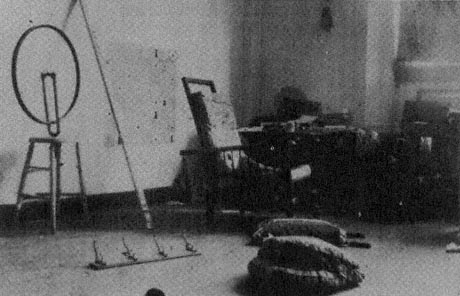
Figure 41.
Photo of Duchamp's studio in New York, c. 1917-18
late grinder; for the wheel and the rack to stand for definite ideas made them function like the malic molds, which symbolized the social identities that erotic arousal dissolved into pure maleness, and the grinder, which stood for male autoeroticism. The difference was that they were not intended to be publicly shown, and so spoke their metaphorical message to Duchamp alone.
Even after he began to employ the term "readymade" in 1915 and to choose some objects on the later basis of indifference, Duchamp continued to use them to populate his private universe. Visitors to his studio in New York were struck by the way he had filled it with what seemed to them mysterious objects; in 1917 Gabrielle Buffet-Picabia described him there, inhabiting what she called "a kind of Capernaum, surrounded by chosen objects"; a contemporary photo shows something of what she meant (see Fig. 41). She could perceive only disorder in the collection (that is what a "Capernaum" means) because Duchamp alone knew the private language in which his objects spoke to him.[12]
To make visual images into symbols for ideas, as opposed to the pic-
torial conventions that made them stand for things in the world, was part of the turn Duchamp's activities were taking after his return from Munich, his rejection of what he would later call "retinal art." In 1913 he wrote in a note: "Can one make works which are not works of 'art?' "[13] We cannot come upon this question now without seeing its relevance to the departures Duchamp would make in the years to come, but in reading it we need to remember that he had not yet established readymades as a category nor begun to think of ordinary objects as alternatives to paintings. In the context of what he was doing in 1913, the question meant something closer to what he intended in calling the Large Glass a "delay," that is, a work that was not a "picture" in the sense of a set of images representing things outside itself, but a network of symbols that remained within its own complex universe of ideas. The projects Duchamp imagined as responses to this question were similarly conceived to evoke mental contents instead of representing objects: one was the proposal we took note of earlier, in which two identical but differently sized objects (deck chairs were the homey example) could provoke optical illusions suggestive of the fourth dimension.
Whether these early objects contained some inherent potential to enter the sphere of "art," even without Duchamp being conscious of it, we need not try to decide here. There is no doubt, however, about what it was that actually transformed them into art objects: it was Duchamp's trip to America. That he found a word for the readymades there was only part of what happened. Equally important was the reception he and his pictures were given, and the new ways of relating to the public this created.
Duchamp's American fame, as we noted at the start, was both explosive and paradoxical, plucking him out of obscurity while veiling his particular features, causing him, as he later put it, to disappear behind his picture. Such a way of appearing in public without recognizable features was precisely what the later Duchamp would seek, the very artistic persona he cultivated through the turn to readymades.[14] But the commotion over Duchamp at the Armory Show had the additional feature that it made him a celebrity by virtue of the very mystery and uncertainty radiating from his work; he became the representative of
modern art because the puzzle about what was being represented in Nude Descending a Staircase encouraged viewers to associate the picture's diffuse, vaguely sexual energy with the avant-garde's rejection of tradition, its ambiguous, contestatory spirit, and its vague promise of entry into realms of perception beyond the everyday.
Duchamp's status as the representative vanguard artist gave him a kind of abstract, charismatic power, cut loose from the particular content or meaning of his work, allowing him to move his audience not just in spite of his incomprehensibility but because of it. When his American viewers professed to find in the Nude such objects as "Food Descending a Staircase," "disused golf clubs and bags," "half-made leather saddles," "an elevated railroad stairway in ruins after an earthquake," a "heap of broken violins," or "an explosion in a shingle factory," they were joining him in the project of injecting humor into art, and extending his challenge to traditional notions of what art was and was not. Had derision been the only response to Duchamp at the Armory Show, the implication of this back talk would have been to resist such transformation, but his actual reception instead signaled that in America there was an audience in its own way as ready as he to contest existing ideas about art by expanding its precincts toward objects and experiences excluded before.[15]
In his early responses to America he nearly said as much. From the first he praised the young country to his hosts, describing it in his first interview as the only place where, given the baleful atmosphere of wartime Europe, there were people "yearning, searching, trying to find something."[16] Although he tried to explain the mistake viewers made in looking for a real figure in the Nude —the picture represented no object but "an abstraction of movement"—he did not think the public unable to respond to the larger goal of the new art, declaring at one point, "I think it is more the execution than the spirit which is misunderstood and not comprehended." He put forth that expression of confidence in America during a joint interview with Albert Gleizes, Francis Picabia, and Jean Crotti, all of whom described America as a fertile ground for the development of vanguard art. In the interview, the most fully worked-out account of this harmony came from Marius de Zayas, a Mexican-born caricaturist and critic who lived in New
York, worked with the photographer and gallery owner Alfred Stieglitz, and visited Paris in 1910 to learn about recent currents in modernism. De Zayas's comments on America deserve to be quoted at length; if they do not exactly represent Duchamp's own sentiments, they convey ideas that were being expressed in his presence, and whose general import he approved.
In all times art has been the synthesis of the beliefs of peoples. In America this synthesis is an impossibility because all beliefs exist here together. One lives here in the present, in a continuous struggle to adapt one's self to the milieu. There are innumerable social groups which work to obtain general laws. But no one observes them. Each individual remains isolated, struggling for his own physical and intellectual existence. In the United States there is no general sentiment in any sphere of thought. America has the same complex mentality as the modern artist; the same eternal sequence of emotions and sensibility to surroundings; the same continual need of expressing itself in the present and for the present, with joy in action, and with indifference to "arriving." For it is in action that America, like the modern artist, finds joy.
Such a view of modern art, sacrificing the specifically aesthetic goals of fauves or cubists to the broad project of freeing art from all general standards, thereby making it primarily an active response to present conditions and a form of expression cut loose from traditional aesthetic means and goals, seems almost a prophecy of what many of Duchamp's later admirers—along with some of his critics—would find exemplary in his career. Duchamp himself on this occasion agreed enough with De Zayas to argue that vanguard artists were all working toward a shared goal, each one in a particular, individual way, concluding that "Art is all a matter of personality."[17]
Duchamp spoke about his own personality on this occasion in terms of constant change in style and manner, declaring (as we noted above), "In the midst of each epoch I fully realize that a new epoch will dawn." He did not associate this fluidity with the readymades, as he later would, but in the atmosphere that surrounded the French artists trans-
planted to New York, a move like the one that would lead him to offer ordinary objects as art seemed just around the corner. In fact Duchamp was not the only person to make it; at the time he chose a snow shovel as the first designated readymade, Duchamp was sharing a studio on lower Broadway with Jean Crotti, a young Swiss artist who would later marry his sister Suzanne, released from her tie to the pharmacist. Interviewing the two together early in 1916, a reporter for The Evening World noted that Duchamp was already well known for the Nude , "the sensation of the Armory Exhibition three years ago." But it was Crotti who had most to say about two objects given a prominent place in the shared studio: a pair of muddy rubber galoshes, which he was quoted as declaring "much more interesting and decorative than a pretty woman, considered from the point of view of art," and a "huge, shiny shovel suspended from the ceiling," over which he exclaimed: "As an artist I consider that shovel the most beautiful object I have ever seen." The beauty of women appealed to him as a man, but it had nothing to do with what he was seeking as an artist. Along with the work of the two young Europeans, these opinions caused the writer to say that the gallery show where both would soon be exhibiting would be a kind of "world championship" of "the eccentric and the new in art."
That it was Crotti and not Duchamp who had most to say about these objects—one of which, the pair of galoshes, perhaps deserves a place it has never received in the history of the readymades—is only one remarkable feature of their joint interview. Equally revealing about the situation in which Duchamp's readymades became public art is the mix of shock and matter-of-fact acceptance with which the journalist reported on his encounter with the two artists, so outlandish in their views that nothing they did or said deserved surprise. Crotti had serious reasons for valuing ordinary objects: they underscored art's distance from nature and from sentiment, its search for the imperceptible lineaments of pure form. But his words also make clear that he understood the shock value of his ideas, which were bound to leave his hearers gaping in uncertainty about whether he meant what he said or not. Was he pointing to some profound truth or laughing behind people's backs? It was this ambiguity that made irony the medium through which Duchamp and his friends were bound to relate to their audience,
especially in America. Duchamp had been no stranger to irony before, as we have already seen at length, but it was in New York that irony first became a defining feature of his relation to the public, drawn to him precisely in response to the uncertainty of his intentions. Being in America encouraged Duchamp to give greater scope to this side of his personality: was he a figure of mystery or of blague ? Was he pretending when he seemed to be serious or when he appeared to be joking?
Once the atmosphere surrounding Duchamp and his friends in New York is recalled, it is not hard to see how it encouraged him to look differently on the objects which had so far born only a private symbolism and spoken to him alone. Thinking about them as "art" was just the sort of action—comic and yet mysteriously serious—that his American hosts expected of him. It may be that an additional encouragement to take this turn came from the circumstance that, in the midst of all his celebrity, he had no new work to offer. In contrast to what he would later say, he did not attribute this to having made some major decision against painting at the time of his trip to Munich; he merely declared that putting the manner of the Nude and the king and queen pictures behind him showed his penchant for constant movement and his lack of attachment to any single style. Nor did he speak about the Large Glass as a project that drew his energies away from more traditional painting; he accounted for the fact that "I have not painted a single picture since coming over" to America by saying that the active and interesting life he was leading in New York made him "very happy.... Perhaps rather too happy."[18]
This was the context within which he wrote in mid-January 1916 to his sister Suzanne, telling her that he had bought some objects and treated them as readymade by signing them and giving them English inscriptions; one was the snow shovel (whether it was the same one that Crotti would speak about in the April interview seems impossible to say), which he labeled—Duchamp's first public attempt to speak nonsense in English—In Advance of the Broken Arm (Fig. 42), and a second, unspecified (and now unknown, since it has disappeared), titled Emergency in Favor of Twice . (Although it is tempting to ask whether it might have been the pair of galoshes, the answer seems at best doubtful, since the inscription might too easily appear to have a literal con-
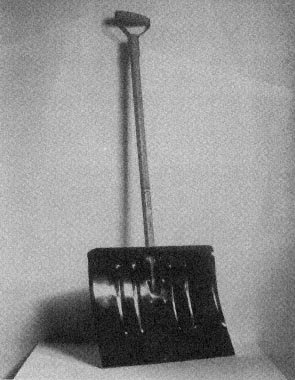
Figure 42.
Duchamp, In Advance of the Broken Arm (1916)
nection with them.) Reminding her of the bicycle wheel and the bottle rack that had been in his studio—by then cleaned out, so that unbeknownst to him the objects were already lost—he proposed to treat the rack as a readymade "from a distance," asking Suzanne to write an inscription inside its bottom ring and sign it for him.[19]
At this point the category of readymades clearly existed, but it seems not to have been as capacious as it later became. Although he mentioned the wheel to Suzanne, Duchamp did not propose to include it with the other objects, perhaps because, having been altered by mounting on a stool, it had not been taken up like an item of ready-to-wear clothing from a shop; nor was there any reference to Pharmacy . Could it be that the reason Duchamp soon thought up the idea of "assisted readymades" was in order to make room for these objects? Of the things he would designate in the months to come, one was altered in a manner analogous to the wheel, the ball of string mounted between two brass plates joined together by long screws (an unknown object
was placed inside the string, which made a sound when the assemblage was shaken, hence the title With Hidden Noise [Fig. 43]), while the other paralleled Pharmacy , an advertisement for Sapolin paints punningly transformed into Apolinère Enameled (Fig. 44). In addition, two unaltered readymades joined the group at this time, one a comb, apparently chosen following the recipe in his notes for planning to designate a readymade at a given future time, and the other an Underwood typewriter cover, perhaps from the typewriter Duchamp himself seems to have acquired at the same time (something more will be said about it in the next chapter). His notes also contain the proposal—never acted on—to "find an inscription for the Woolworth Building as a readymade."
Nothing survives to tell us what Duchamp had in mind in assembling this series of "works," but it seems that neither his later notion of the genre as a liberation from habit nor his later sense that they were part of a campaign against art was in play, the first because Duchamp already regarded himself as a person in constant motion between styles without having to rely on the readymades, and the second because none of them had the provocative edge the genre would acquire a few months later when the famous urinal was submitted to an exhibition. Duchamp's early comments on New York stressed the qualities that made it hospitable to advanced art, and Crotti's enthusiasm for the galoshes and the snow shovel, expressed in Duchamp's presence, was premised on the ability of such objects to represent what set art off from nature, not on a rejection of aesthetic values. That Duchamp first experienced the readymades as continuous with his artistic preoccupations at the time, and not as a way of turning against art, is made still more likely by the linguistic link between the term and the forever ready maid of the Large Glass; nothing would have been more in character than for him to have been initially attracted to the English word when he first encountered it by the punning reference it recreated to the project on which he had recently begun to work, so that applying the term to the objects he had previously assembled located them in an imaginary realm of echoes and allusions to the drama of eternalized desire, of whose existence only he was then aware.
At the same time, the turn to readymades gave Duchamp a way to
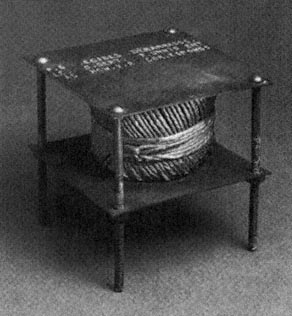
Figure 43.
Duchamp, With Hidden Noise (1916)
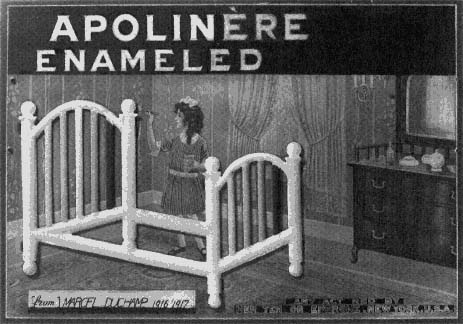
Figure 44.
Duchamp, Apolinère Enameled (1916-17)
be active artistically at a time when he had no other "works" to offer to a curious and interested public, one whose response to him suggested it would accept whatever he did as "art." The group for whom they were intended seems to have been limited to just this public; most were quickly acquired by the Arensbergs for their private collection (according to one story the shovel was brought to their apartment immediately on being inscribed, where it was received with amusement that must have been tempered by the awe in which Arensberg clearly held Duchamp), and only the typewriter cover seems to have been displayed in a gallery, where it attracted little notice.[20]
What happened next forever changed the status of Duchamp's readymades, putting all of them in a different light. This was the gesture of sending an ordinary porcelain urinal, mounted on its side, signed "R. Mutt" ("R" for richard , French for moneybags, and "Mutt" from the comic-strip companion of "Jeff") and titled Fountain , to the exhibition organized by a group calling itself the Society of Independent Artists. Although Duchamp's urinal is usually taken to be one of his most outrageous and aggressive acts of "anti-art," his decision to display it looks a bit different when put in context. The manner of organizing the show was almost enough in itself to provoke some such challenge; artists were placed alphabetically within it, and its motto was "no jury, no prizes." Submitting the urinal seems to have been more a way to test the bona fides of the organizing committee—would they really take anything?—than an affront to the public; in the atmosphere we have been discussing, some viewers might well have enjoyed likening the urinal to other works whose claim to being art they doubted (one critic called the show "democracy run riot"), a comparison unknown artists desirous of being taken seriously would not have welcomed. The committee (Duchamp was a member, but the others, perhaps suspecting who lurked behind "R. Mutt," did not consult him) acknowledged its own principles sufficiently not to reject the urinal officially, placing it behind a partition where it seems nobody saw it.[21]
The incident recalled Duchamp's contretemps with the Salon des Indépendants five years earlier; in both cases his work pitted him more against his fellow artists than against the public. Now, however, Duchamp was prepared to exploit the incident instead of fleeing. Writing
to his sister he said that he had resigned from the committee, but that what had happened would be "a scandal of some value in New York."[22] Together with his friends Louise Norton, Henri-Pierre Roché, and Beatrice Wood, all members of the Arensberg circle and all, like Arensberg himself, in on the ploy from the start, Duchamp now set out to cultivate the scandal, publicizing the incident and getting it written up in newspapers. In fact, in the letter recounting the story to his sister (before whom he had no reason to dissemble) Duchamp said that the urinal had been sent in not by him but by "one of my female friends." Without diminishing Duchamp's central role in giving the readymades a new life at this moment, we need to recognize that others were also involved; the gesture in fact grew out of the whole atmosphere that surrounded the avant-garde in general and Duchamp, as its exemplary representative, in particular in New York just before America's entry into the war.[23]
For all that, Fountain resembled the earlier objects Duchamp had picked out in that it too was able to stand as a symbol of his own artistic—and personal—preoccupations. Like the bottle rack, although with a different rhetoric, it called up the imaginary relations between male and female personae that existed in his conception of the Large Glass. The urinal functioned as a "male" object in its ordinary use, but its shapely, curvilinear form suggests elements of a female body, especially when turned to place its narrow lip upward, as in the photo Duchamp had Alfred Stieglitz do of it (Fig. 45). This was recognized at the time, for instance by Carl Van Vechten, a journalist and critic tied to the Arensberg circle, who wrote to Gertrude Stein that "the photographs make it look like anything from a Madonna to a Buddha."[24]
Extracted from its context and turned so that it cannot be used as intended, the urinal has become a female presence forever removed from the male action that would bring it into the world of ordinary experience, a representation of "delay" in the sense of the Large Glass and a kind of female counterpart of the bottle rack. In Duchamp's Box of 1914 , the first and briefest installment in the serial publication of his notes, there appears the enigmatic declaration: "—one only has: for female the public urinal [pissotière ] and one lives by it."[25] None of Duchamp's sybilline utterances have remained more impenetrable than
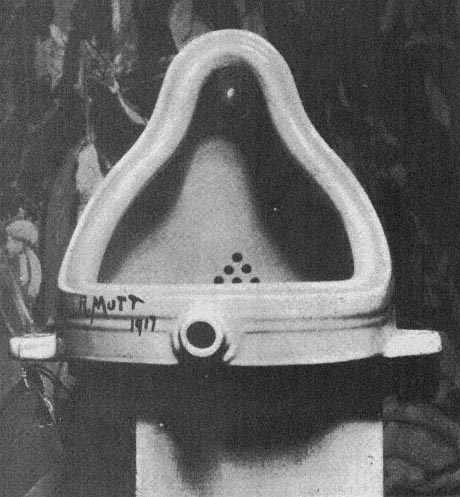
Figure 45.
Alfred Stieglitz's photo of Fountain (1917)
this one, but it begins to make sense if read as a thought about a possible female object to correspond to the male bottle rack, which he took into his life at roughly the time he wrote this note. Whether that reading is on the mark or not, it is clear that Duchamp had the urinal in his mind several years before 1917, at a time when the category of readymades did not yet exist, and when the objects that would later be included in it still remained within a private universe of symbols.
Tied in this way to his inner world, Fountain also entered the field
of irony where Duchamp met his public. At the time, several claims were made for it that recall Crotti's enthusiasm for the galoshes and the snow shovel, both in their content and in their ambiguous seriousness. Beatrice Wood reported that Walter Arensberg tried to convince another member of the organizing committee that the work should be shown by arguing that "a lovely form has been revealed, freed from its functional purpose; therefore a man clearly has made an aesthetic contribution.... Mr. Mutt has taken an ordinary object, placed it so that its useful significance disappears, and thus has created a new approach to the subject."[26] Louise Norton published an article called "Buddha of the Bathroom" in The Blind Man , a short-lived journal put out by Duchamp and his friends. Against the complaints of indecency, she proclaimed the readymade's "chaste simplicity of line and color," noting that some had compared it to a Buddha, others to women's legs in paintings by Cézanne; she justified the second comparison by proposing a visual pun wholly in Duchamp's spirit: "have they not, those ladies, in their long, round nudity always recalled to your mind the calm curves of decadent plumbers' porcelain?" Fountain , she insisted, was "not made by a plumber but by the force of an imagination."
But faced with the question "Is he serious or is he joking?" Norton's reply was: "Perhaps he is both! Is it not possible?" Given the contradiction between modern society's celebration of progress and change and its backward-looking yearning for stability, she went on, was it surprising that artists responded with blague ? The best equivalent she could offer for the work's combination of outlandish parody and serious seeking after pure form was the ironical word of the symbolist critic Rémy de Gourmont: "perhaps."[27] Norton did not add that it was Gourmont who said of the personal art rooted in the interior of individuals—for him and his symbolist colleagues the only true art—that such work was always "more or less incomprehensible."
Some portion of Fountain 's complex of private resonance and public ambiguity reappears in the other of Duchamp's great challenges to artistic convention, the altered Mona Lisa. Taking a postcard reproduction of Leonardo's portrait, Duchamp added a moustache and beard,
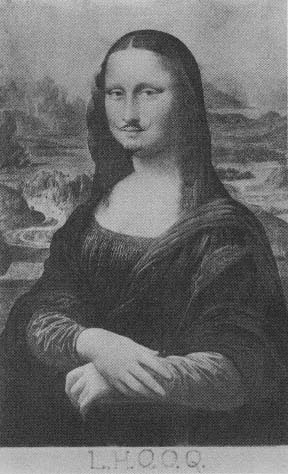
Figure 46.
Duchamp, L.H.O.O.Q. (1919)
writing underneath the now-famous legend L.H.O.O.Q. (Fig. 46). The scandal of treating so revered a masterpiece so disrespectfully has made it difficult to see in Duchamp's gesture anything more than a piece of dada iconoclasm, and at times he described it this way himself. But here too the work's ability to outrage viewers hides its complex reference to Duchamp's inner world. Taken together, his two additions to Leonardo's picture—the legend and the facial hair—make her a representation of a desiring woman who produces on her own body the symbols of the male whose desire corresponds to hers. Like the bride of the Large Glass, she has become a female figure who remains fully clothed while imagining her own stripping, her desire blossoming out
of her in such a way that it causes her to project an image of the generalized partner who remains forever just out of her reach; meanwhile the Mona Lisa we see is only a reduced projection of the other, real one, who remains serene and pure, the apotheosis of feminine mystery, in another "dimension," a place where the bachelor Duchamp cannot touch her.
Duchamp had no hostile feelings toward Leonardo; quite the contrary, the Renaissance master represented the more intellectual and conceptual kind of painting he preferred over the "retinal art" of nineteenth-century realist schools. As he recalled later on, he did not display his altered Mona Lisa in any exhibit: "I drew a moustache and a beard, that's all. I didn't show it anywhere." André Breton may have known about it, but it came to public light only when Francis Picabia saw it as Duchamp, in Paris during 1919, was about to pack it in his bag to go back to New York. Picabia then published a version of it in the dada magazine, 391 .[28] We will never know exactly what Duchamp's intentions for making the piece public were, but for some time at least it existed as a private object, an emblem of his own preoccupations; like other readymades, it migrated later from this personal realm to the public space where its import necessarily altered.
It seems, moreover, that in Duchamp's own mind his revised Mona Lisa never lost its reference to the mental universe of the Large Glass. The evidence for this is that later on, at the time he was working on Given , he did another version of the Mona Lisa readymade, transforming it in a way precisely parallel to the "completion" of the Large Glass provided by his posthumous work. The second Mona Lisa, done in 1965, consisted of a playing-card photo of Leonardo's painting, bearing the same five letters below it, but without the facial hair. Underneath he wrote rasée , shaven (Fig. 47). No one at the time could understand the reference to the still unknown figure of Given that surfaces as soon as the two works are juxtaposed. The female depicted there was hairless too, a condition that, like the Mona Lisa's, deprived her sexuality of the veil of mystery and ambiguity it had worn before. What remained was a classic woman, degraded by a treatment that made her sexual nature manifest in the crudest possible way. The second Mona Lisa retains the label that proclaims her desire, but she has lost the ability to make her
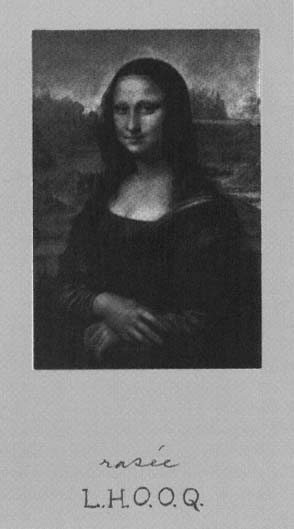
Figure 47.
Duchamp, L.H.O.O.Q., Shaven (1965)
person the place where the symbols of the partner she does not have blossom forth; so has the female figure in Given lost the power to project the bachelor imagery of the Large Glass, the male symbols that were necessary figures in the fantasy theater of the bride's self-imagination as an apotheosis of virginity, "elements of this blossoming, the sexual life imagined by her the bride-desiring." Both have passed from being doubly gendered to having only a single sexual identity, and each thus returns to the world of ordinary bodies, her desire reduced to the purely prosaic and material level where its representation takes
the form of a rude joke. Only the importance the Mona Lisa readymade bore in the economy of Duchamp's private universe of meanings explains the necessity for redoing it in this way.
The original operation Duchamp performed on the Mona Lisa in 1919, giving a male identity to a female figure, probably helped to inspire the opposite turn he gave to his own person a year later, when he reinvented himself as Rrose Sélavy. The two dually gendered figures share several features. The photographs of himself as Rrose, suitably dressed and made up, which he had Man Ray do in 1920 and 1921, have something of the same enigmatic quality that is classically associated with Leonardo's picture, and it would not be hard to say of someone whose name is éros, c'est la vie that L.H.O.O.Q. (Fig. 48). In a sense, Duchamp at this point turned himself into a readymade, and one whose ability to stand for the sexual relations portrayed in the Large Glass was equal to that of the others. Like his work, he now became a dual figure, male in one guise and female in the other, his identity as a person of one sex completed in his mind by the imagination of a partner who was his own mental projection of erotic desire idealized. Such desire remained forever unfulfillable: because Rrose was the eros that corresponded to life itself, she would never betray her lovers by granting them possession, with the consequences of regret and disillusionment we know from the picture Paradise and the note on shop windows. By becoming Rrose, Duchamp turned himself into a representation of the perpetuation of desire that cast the sexuality of the Large Glass into the fourth dimension; she was the link between the fluidity of identity he sought in the readymades—not least by becoming one himself—and the "delay" that preserved the bride and the bachelors from the fate made plain in Given .
That there was such a direct relationship between Duchamp's readymades and his pictures was one of the points he made in his last painting on canvas, the work called Tu m' , done for his friend and patron Katherine Dreier in 1918 (Plate 6). We can leave the enigma of the title aside until we come to Duchamp's experiments with language in the next chapter (where we will also take up the assemblage he called Three Standard Stoppages , the image of which is outlined in the bottom left corner of Tu m' ). The long, thin composition, proportioned so that it
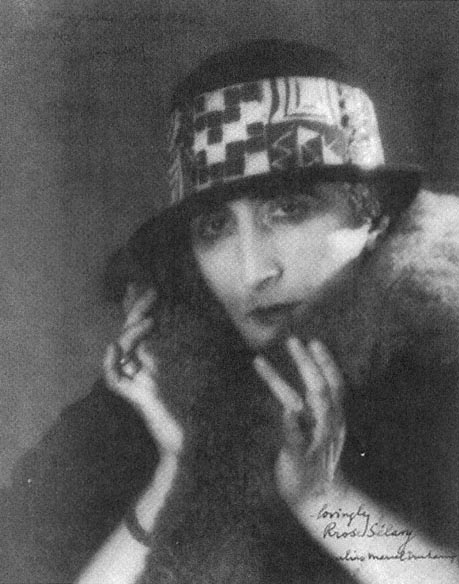
Figure 48.
Man Ray, Marcel Duchamp as Rrose Sélavy (1921)
would fit on a wall above Dreier's bookcase, makes room for a varied collection of Duchamp's objects and interests. Two readymades are represented by shadow images, the bicycle wheel at the left and, on the right, a hat rack, chosen in New York in 1916, perhaps because both its shape and the absence of the hats for which it waits recall the lost bottle rack. A corkscrew, never publicly announced as a readymade but full of sexual innuendo (Duchamp used the image of a corkscrew to describe the trajectory of the liquefied illuminating gas as it fell toward its orgasmic splash in the Large Glass), and perhaps intended to suggest that his imagination still had surprises in store, occupies the center, beneath a row of matboards, recalling those on which his notes were mounted in the Box of 1914 , and receding into an indefinite distance (there would be more to come). The canvas contains a trompe-l'oeil tear that is "repaired" with actual safety pins, setting up a confusing play of relations between "reality" and "representation." A real bottle brush sticks out from the surface toward us the viewers, at once threatening to poke us in the eye if we get too close and echoing, along with the corkscrew, Duchamp's earlier appeal to absent bottles. A realistic hand, done on the canvas by a professional sign-painter, points rightward toward a puzzling construction of threads and bars, divided into sections painted in the colors of the spectrum and enclosed within rows of circular wire rings.
I think that the sign-painter's hand is there to point us toward Duchamp's answer to the questions many had about his strange objects: what did they all mean? what did he intend by occupying himself with them? The answer echoes the metaphor for artistic transcendence he developed in the Large Glass: the fourth dimension. In Tu m' we have one more attempt to represent the fourth dimension visually; the space on the picture's right side is one where our ability to tell a two-dimensional plane from a three-dimensional volume dissolves. The shadow of the hat rack falls on a surface that is at the same time a space; the threads attached to the far edges of the white rectangle move in a plane that is just as close to us as those that come from the near edges, without giving any visual explanation of how they get there; the wire circles around the bars follow a plane that bends from being perpen-
dicular to the bars to being parallel to them; and the edges of the bars are located at one point in space according to the depth defined by the red threads, while they are simultaneously somewhere else according to the depth indicated by the green ones. It is all a kind of visual joke, but how else to represent the conceptual game of the fourth dimension? The sign-painter's hand in Tu m' points in the direction of that "outlet toward regions not ruled by time and space" that art makes us seek and desire and of whose unreality we need always to be reminded, lest by forgetting we confuse it with the world we know and cause it to collapse in disillusionment and banality like the deathly prison of Given . As a painting of his readymades, Tu m' brings Duchamp's disparate activities together, while it seems to proclaim, in an accent tinged by America, a peculiarly Duchampian and avant-garde version of the ancient truth that art is a form of play: the only way to be serious about art is by not being serious about it, the only way to keep it alive is to keep it always under attack.
The moment when the readymades became art objects, leaving his private realm of symbols to enter that of public display, marked a crucial turn in Duchamp's career. Despite the hints of aggressivity one finds in his work before, it was only now that the "sad young man on a train" took on features that would make people associate him with great cultural rebels such as Arthur Rimbaud and Alfred Jarry. Like them he seemed to throw aside the older image of the artist as a person specially able to give a new and personal shape to common, shared experiences, in favor of a vocation to undermine certainties, celebrate instability, and burst open the boundaries of aesthetic activity.
And yet Duchamp remained strangely unlike his predecessors in the art of contestation, free of the desperation that underlay Rimbaud's methodical experiments in visionary self-degradation and of the double-edged violence that Jarry turned at once against the world and against himself. Duchamp's mood of quiet irony, always bordering on indifference, would keep him coolly apart from those—dadas and surrealists—who sought to fire up the engines of artistic rebellion at the end of World War I, and it cast a veil of uncertainty over his most radical gestures, always leaving open the possibility that his real targets were
not what they seemed. The urinal was so effective a challenge to the sacred precincts of art precisely because its claim to embody formal perfection referred to real features of its shape and material, and the gesture of sending it to an exhibit that touted its openness to all comers was a challenge just as much to those who paraded their rejection of tradition as to those who dug in their heels to uphold it.[29] It bears repeating that Duchamp's irony was Janus-faced, undermining its own appearance of pure playfulness with the same mockery that laughed at art's traditional claims to gravity and importance, announcing the rebirth of the artist in the same formulas that declared the death of art. Duchamp found pleasure and amusement in the public scandals that grew out of the readymades, but he remained a deeply private person, often finding ways to withdraw from view, always maintaining his conviction that what was valuable in art had to emerge from the interior of a personality, and seeking new ways to protect his own private spaces against corruption by the world outside.